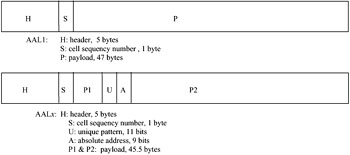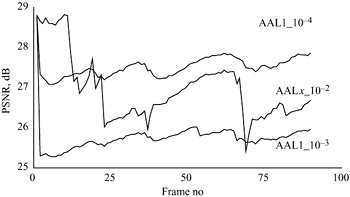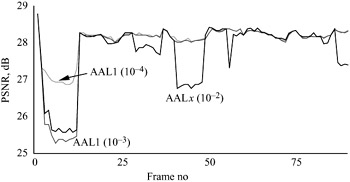8.8 Video over ATM networks
8.8 Video over ATM networks
MPEG-2 and in particular layered video coding and the asynchronous transfer mode (ATM) networks have a very strong link. They were introduced at about the same time (early 1990) and influenced each other's development. The cell loss priority in ATM is the direct product of the success of layered two-layer video coding in delivering a minimum acceptable picture quality [9]. Selection of 188-byte packet size for the MPEG-2 transport stream was influenced by the ATM cell size. An ATM cell (packet) is 53 bytes long with a five-byte header and a 48-byte payload. One of the ATM adaptation layers (AAL) (where the data to be transported is interfaced to the channel) called AAL1 accepts 47-byte raw data, and adds one-byte synchronisation and other information to the payload [15]. Hence each MPEG-2 packet can be transported with four ATM cells.
ATM is a slotted channel, where each 53-byte cell is seized by the server to insert its data for transmission. If the server has nothing to send, the cell is left empty. Hence, the source can send its data at a variable rate. Variable bit rate (VBR) video transmission is particularly attractive since compressed video is variable in rate by nature. With a constant quantiser step size, the video is coded at almost constant quality. At low picture activity (low motion and low texture) less bits are generated and at high picture activity more bits are generated. Such variable bit rate transmission makes statistical multiplexing even more effective than the one used with fixed bit rate broadcast TV. It is easy to show that more variable bit rate services can be accommodated in a given channel than the fixed bit rate services.
The main problem with VBR transmission is that, if bursts of data from various services occur at the same time, there will be more traffic than the network can handle and it will be congested. In this case, cells carrying visual information might be excessively delayed. There is a maximum tolerable delay beyond which late arrival cells will be of no use. Either the switching nodes or the receiver can discard these cells. In the former case, the cell discard is due to the limited capacity of the switching multiplex buffer, and in the latter, the received information is too late to be of any use by the decoder. In both cases, loss of cells leads to degradation in picture quality.
The cell loss priority bit in ATM cells coupled with two-layer video coding can enhance the video quality significantly. Here the base layer video is assigned high priority and the enhancement layer lower priority. In the event of network congestion low priority cells (enhancement data) can be discarded and room made available to the high priority cells (base layer). For example, even in the normal MPEG-2 with a GOP structure of N = 12 and M = 3, which can be regarded as temporal scalability, during the network congestion all the B-pictures can be temporarily discarded to make room for the I and P-pictures.
In ATM networks, in addition to layering, the packetisation strategy also plays an important role in the video quality. One form of packetisation may confine the effect of a lost packet to a small area of the picture, while other methods may spread degradation to a larger area. With AAL1 packetisation [15], where every 47 bytes of the bit stream are packed into the ATM cell payload without any further processing, if a cell is lost, the following cells may not be recoverable until the next slice or GOB. Thus a large part of a picture slice may be degraded, depending on the location of the lost macroblock. This problem can be overcome by making the first macroblock of each cell absolutely addressed, hence the loss can be confined to a smaller area of the picture [18]. Let us call this method of packing AALx, as shown in Figure 8.27.

Figure 8.27: Structure of ALL1 and AALx cells
In AALx, where the first macroblock in each ATM cell is absolutely addressed, the lost area could be confined to the area covered by the lost cell. All following cells could then be decodable. For the decoder to be able to recognise the absolute address, an additional 11-bit header (absolute address header) must be inserted before the address. Also, the average length of the relative addressing is normally two bits, whereas the absolute address can be nine bits long, resulting in an additional seven bits [18]. Thus AALx has an almost five per cent extra overhead compared to AAL1. Referring to the multiplex cell discard graphs, this can result in five to ten times more cell loss, depending on the network load and the number of channels in the multiplex [19].
In an experiment, 90 frames of the Salesman image sequence were MPEG-2 coded with the first frame being intra (I-frame) coded and the remaining frames predictively (P-frame) coded (N = ∞, M = 1). Two types of packetisation method, AALx and AAL1 were used. The AALx-type cells were discarded with the ITU-T cell loss model with a cell loss rate of 10-2 and a mean burst length of 1 (see Appendix E) [20]. Those of AAL1 were discarded at cell loss rates of 10-3 (10 times lower) and 10-4 (100 times lower) with the same mean burst length. From Figure 8.28, it can be seen that AALx outperforms AAL1 at ten times lower cell loss rate, but is inferior to AAL1 with a cell loss rate of 100 times lower. Considering that in the experiment AALx is likely to experience five to ten times more loss than AAL1, AALx is a better packetisation scheme for this type of image format (e.g. H.261 or H.263).

Figure 8.28: PSNR of MPEG-2 coded video sequence GOP (IPPPPPP...) (a AALx with error rate of 10-2) (b AAL1 with error rate of 10-3) (c AAL1 with error rate of 10-4)
In another experiment the same 90 frames of the Salesman image sequence were MPEG-2 coded with a GOP structure of N = 12, M = 1. The packetisation techniques were similar to those of the previous experiment. In this case, shown in Figure 8.29, AALx does not show the same improvement over AAL1, as was the case for Figure 8.28. In fact its performance, due to higher overhead, is worse than AAL1 with ten times lower cell loss rate.

Figure 8.29: PSNR of MPEG-2 coded video sequence with 12 frames per GOP (IPP... IPPP ...IP...) (a AALx with error rate of 10-2) (b AAL1 with error rate of 10-3) (c AAL1 with error rate of 10-4)
The implications of these two experiments are that with MPEG-1 and 2 structures, where there are regular I-pictures every N frames, AAL1 outperforms AALx. But for very large N (e.g. in H.261) AALx is better than AAL1.
It should be noted the video quality can be improved by concealing the effect of packet loss or channel errors. In MPEG-2 there is an option that additional motion vectors for I-pictures are derived and they are transmitted in the following slice. In case some of the macroblocks are damaged, these motion vectors are used to copy pixels from the previous frame, displaced by the amount of motion vectors to replace the damaged macroblocks. In the next Chapter more general forms of concealing side effects of packet losses and channel errors will be discussed in greater depth.
EAN: 2147483647
Pages: 148
- Structures, Processes and Relational Mechanisms for IT Governance
- Integration Strategies and Tactics for Information Technology Governance
- A View on Knowledge Management: Utilizing a Balanced Scorecard Methodology for Analyzing Knowledge Metrics
- Managing IT Functions
- The Evolution of IT Governance at NB Power